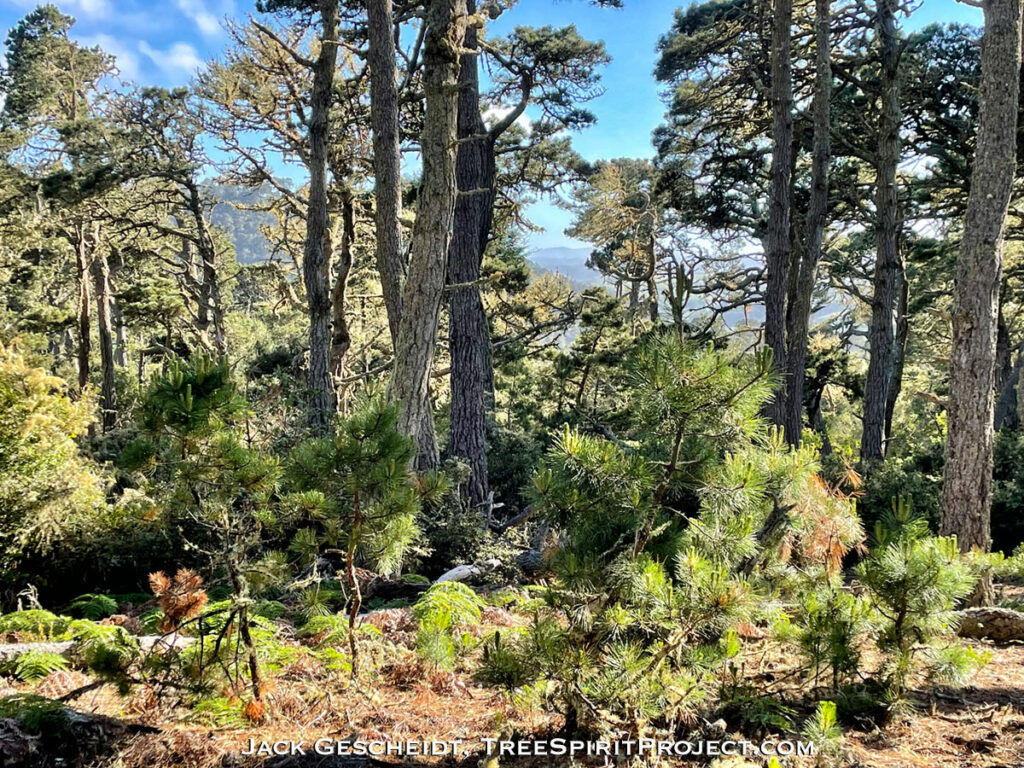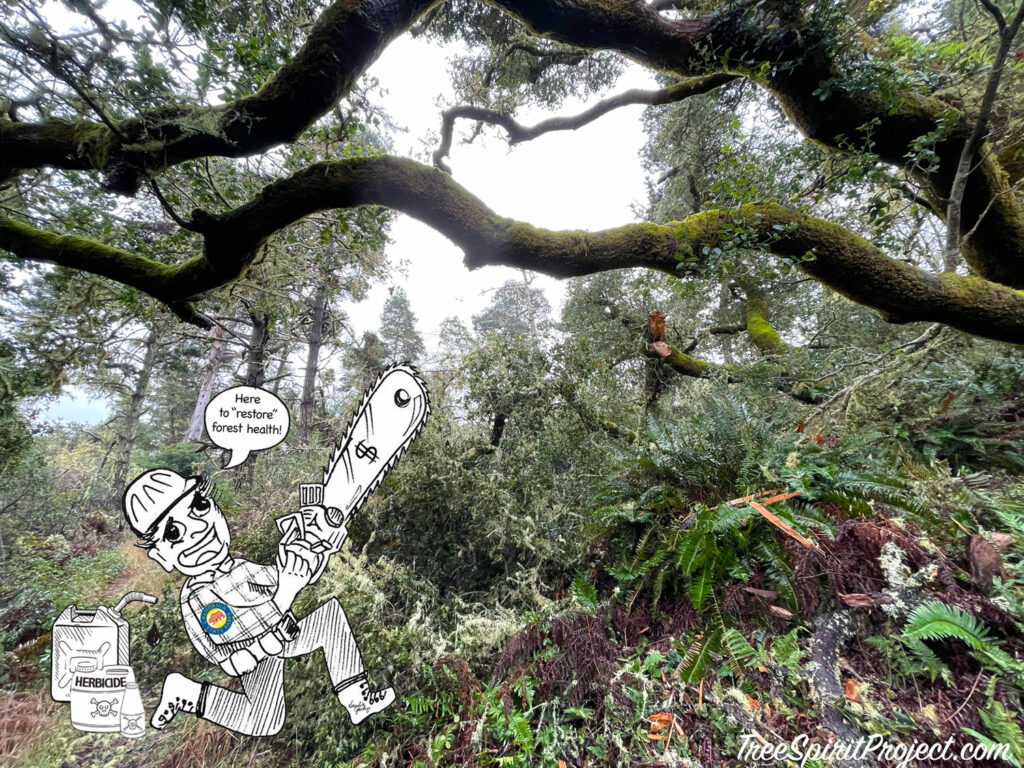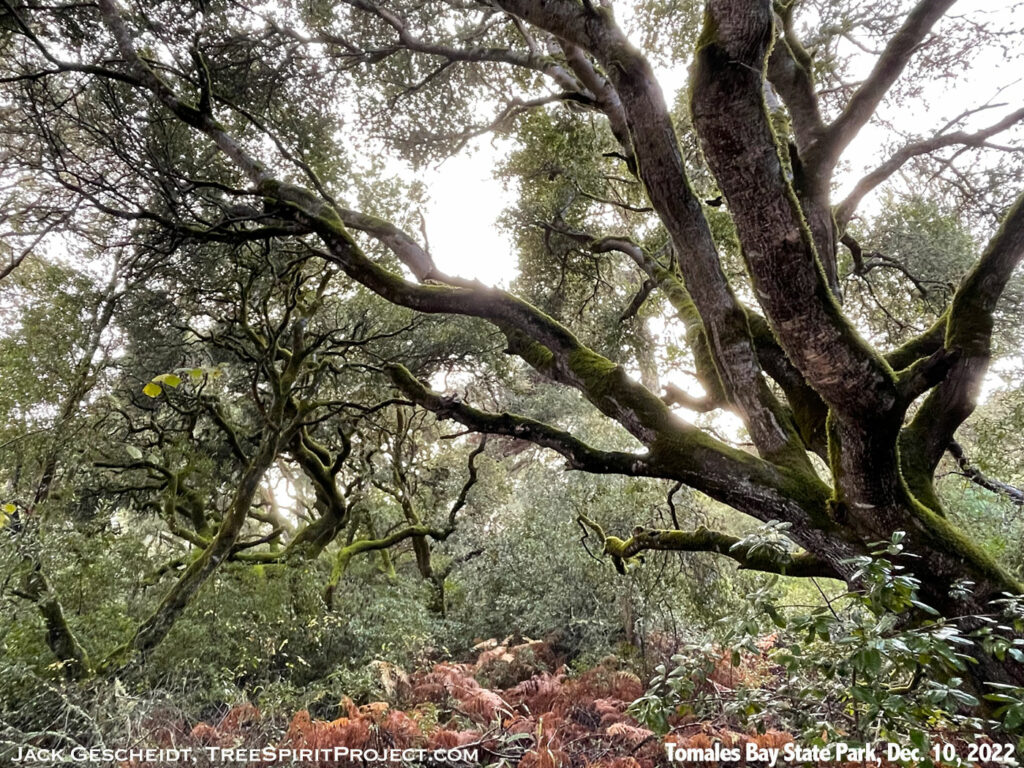
Killing a Forest In Order to “Save” It
A current (2023-24) forest “management” project to “restore” the alleged poor condition of a healthy, wild forest at Tomales Bay State Park, on the Point Reyes peninsula of west Marin County, CA, deploys Orwellian language to make claims to justify the project. Beginning with the project’s up-is-down, black-is-white name, the “Tomales Bay Forest Health and Wildfire Resilience Project” — which prescribes chainsaws, masticating machines, chipping machines, and herbicides as its forest health-restoring “treatments.”
These industrial “treatments” would fell hundreds of tres and shred with masticating machines thousands of bushes and shrubs. This killing spree would denude and desiccate the forest, scare off thousands of forest mammals and birds, and even increase wildfire risk.
Contractors would, for ten long years, be trampling, compacting and hacking away at this dense, healthy forest’s trees and understory vegetation. And then poison more plants, and rich, damp forest soil with gallons of herbicides, in ongoing applications, for years.
The result would, after the project’s proposed decade of mechanized and chemical assaults, be thousands of fewer plants, and hundreds fewer trees. Acres of forest floor would be exposed and laid barer, and end up getting more sun, and becomes drier, hotter. The forest would be windier, which will increase the risk wildfire ignition and ferocity. Ironically, the project claims the opposite, arguing that killing plants reduces the “fuel load” of a forest, its secondary stated goal. Trouble is this ignores that dense forests retain more moisture and, especially in this coastal forest, generates and holds more fog.
This assault of gasoline-powered and chemically-derived “treatments” is billed as necessary to “restore” aging Bishop pine tree stands. But the blizzard of alleged benefits is purely speculative, beginning with the claim that the pine tree stands living here for hundreds of years won’t naturally regenerate, meaning with human assistance. Even though hundreds of young pines dot the forest. (See PHOTO BELOW.)
Baby Bishop pines growing naturally in this forest, without “help” from chainsaw medicine, and herbicide “treatments.”
The deforestation project’s description even asserts that Bishop pines should regenerate now, on our human timetable, accelerated by this project. But why? What science or studies have been done in this forest to justify this claim?
We humans have heated the climate, producing hotter and drier summers and autumns here in California. Nature’s wisdom, from tens if not hundreds of thousands of years of evolution, will regenerate these pine stands on their own, wiser timetable than the one determined by the California State Parks bureaucracy. Cal Parks is driven by other factors, especially the quest for millions of dollars of budget funds to justify its existence, not forest ecology or any established ecological forest science.
The project plan doesn’t offer a detailed, peer-reviewd scientific study of this specific area’s unique coastal, bayside weather and ecology to support its diagnosis of disease, nor its remedial treatment claims. Specifically, and critically lacking, is any site-specific Environmental Impact Report (EIR). Only a general, so-called “Programmatic” EIR (aka, PIER) is referenced, which makes generalized ecological claims, assumptions and speculations based on different habitats, with different species of plants, and different geography, hydrology, climate and weather patterns.
Healing a forest with chainsaws and herbicides?
To challenge the absurdity and gross harm of this industrial forest assault, a growing number of environmental and animal advocacy groups has coalesced, including the TreeSpirit Project, In Defense of Animals, Western Watersheds Project, and The California Chaparral Institute. All have signed a detailed, science-based comment letter by Western Watersheds Project excoriating this project for what it is, a deforestation project. Because it will literally reduce the amount of forest at Tomales Bay State Park.
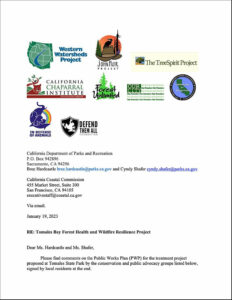 READ blistering “Scoping Letter” critique of the Cal Parks deforestation project, by a biologist with The Western Watersheds Project:
READ blistering “Scoping Letter” critique of the Cal Parks deforestation project, by a biologist with The Western Watersheds Project:
The Big Question: Why deforestation?
What is actually driving this deforestation project? Its claims of poor forest health and wildfire danger mitigation are unsubstantiated, if not patently false. The project plan includes neither of the industry-standard structures protection measures of defensible space and home “hardening” treatments for nearby houses and communities. [READ Firewise® safety measures]
California State Parks Department (aka, Cal Parks), partnered with Cal Fire, the two California state agencies spearheading this multi-million dollar forest-reduction project, want to begin in the autumn of 2024. Typical for a bureaucracy, despite the project’s 62-page proposal, Cal Parks does not disclose many details, including an estimate of the number of trees it will cut down over the so-called “treatment area” of approximately 2,000 acres of Tomales Bay State Park’s forests on either side of Tomales Bay. As is often the case with large publicly funded projects like this, they are unlikely to ever disclose details. First, they are not required to do so. And second, doing so because it would spook the public. People are more pliable when kept under-informed.
For Cal Parks and Cal Fire, the less public information provided, the better their chances of successfully forcing a project like this on a frightened, misled, intentionally misinformed public.
Cal Parks’ project plan doesn’t provide many actual numbers — including its estimated cost to taxpayers — so we environmentalist activists must assume the worst. Meaning, we expect hundreds of trees both living and dead standing (“snags”) will be felled. Plus hundreds more, smaller plants to be shredded by industrial masticators in a mechanized assault. Forest health will suffer dramatically, including soil health, since healthy soil will be poisoned with the herbicides included in this “forest health” “initiative.” Chemical herbicides like triclopyr, which is the main ingredient of formulations like Dow Garlon®, that will be applied on a living forest to prevent plants from growing back where they are labeled inappropriate or problematic. But by what criteria?
READ MORE about Invasion Biology.
Ten years of noise pollution, air pollution, and plant-killing will accompany trail closures. The silence of this rural forest, inside a state park, will b e shattered for a decade of a movable beast of mechanized destruction.
Gallons of herbicides, appropriately banned in many counties, will poison soil, harm and kill beneficial insects, which then poison birds who eat them, and mammals in the food web. Herbicides also desiccate plants, thus increasing wildfire danger too. Herbicides are persistent poisons and endocrine disruptors, shown to cause cancer, and should all be banned, period, let alone be used in a wild forest visited by the public.
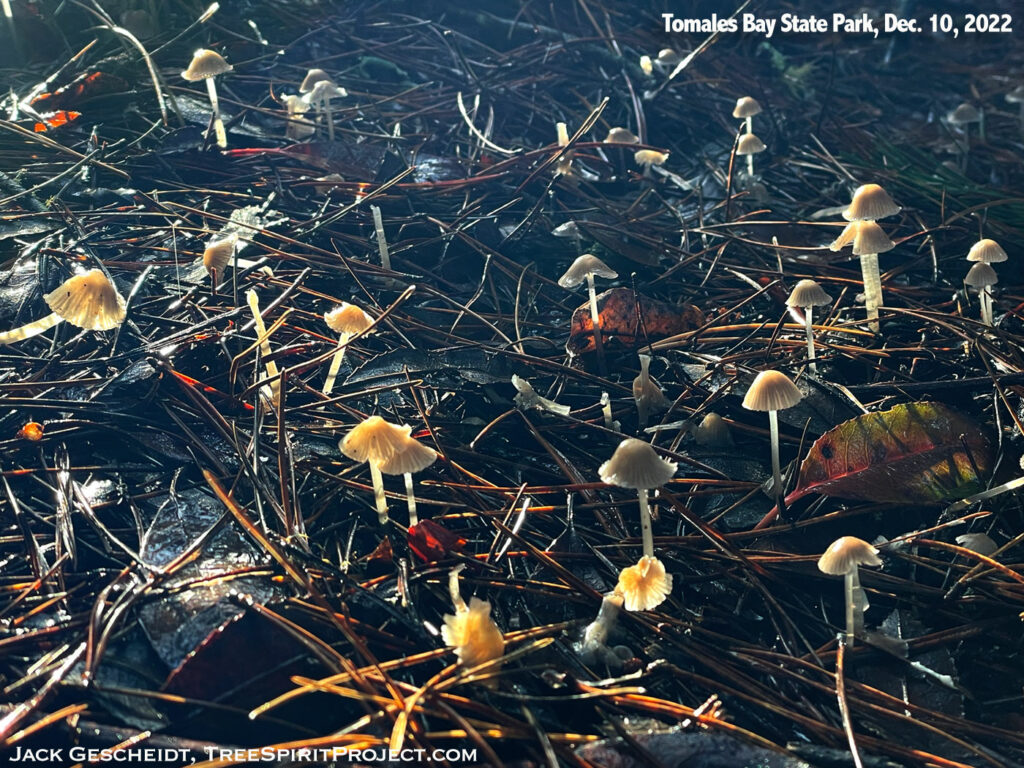
Mushrooms galore in this wet, unmanaged forest.
Fallen trees in the Tomales Bay State Park forest serve numerous, vital ecological functions, and should not be “removed” or cut down. The same goes for dead, standing trees (aka, snags), and downed trees in all forests. Downed trees retain water, decay slowly and keep the forest floor wet, fire-resistant and fungi-friendly. What would-be “managers” of forests call “messy” and “overgrown” is precisely what makes an UN-managed forest so healthy.
But there’s no profit to be made from unmanaged forests. Removing snags, as this project’s planners want to, removes both vital nutrients from the forest and makes the forest drier and more prone to wildfire ignition.
All these issues raise the question, Why? Why does this project even exist? No, it’s not to sell the wood, at least not that we know of. So what is driving this deforestation project? The answer is simpler and more disturbing than that. Perhaps it’s to reduce wildfire danger?
But neither Marin County’s FireSafe program nor the federal National Fire Prevention Assocation’s Firewise program include deforestation (called “thinning” in this project and similar projects by the U.S. Forest Service) in their wildfire risk reduction programs. Instead, these programs focus on home-hardening techniques and creating defensible space from houses-out, especially out to about 20 feet, and to an absolute maximum 100 feet, depending on site-specific factors like terrain and wind direction.
U.S. Forest Service fire scientist Jack Cohen also concurs, endorsing simple, inexpensive, effective house preparations like removing flammable leaf litter and debris on roofs, in gutters, and around houses — but not cutting down trees living or dead. Nor killing (often called “clearing”) plants (called “vegetation” or “brush” to make you think it’s not actually killing living plants). Watch the NPFA YouTube video on home hardening featuring Cohen, “Your Home Can Survive a Wildfire.”
Why won’t Cal Parks even consider first “treating” a small demonstration area of an acre or two, as proof of concept. Do first to a much small area what they propose doing to 2,000 acres, which is killing understory plants, cutting down living and standing dead trees to “open up” the canopy to more sunlight, and applying their toxic herbicides. Observe, measure and quanitify the results. Demonstrate that all their industrialized proposition actually helps aging Bishop pine stands regenerate. This might take a few years, or never happen at all.
But no, Cal Parks offers only a full-scale, industrial-scale assault. And with little public awareness of the size or duration of the project. (It bears repeating: 2,000 acres of destructive “treatments” for 10 years.)
So back to the big question: Why this project? If the proposed “forest health initiative” harms the health of this forest by reducing the amount of forest, and increases forest aridity and wind-driven fires by removing trees, then what’s driving it?
The answer is simple and disturbing: to qualify for funding.
All this manmade let’s call it “Man-Age-ment” is part of an ongoing, coordinated and expanding forest reduction plan for tens and even hundreds of thousands of acres of California’s wildlands. And not just forests, but chaparral habitat of southern California too.
The California Department of Forestry and Fire Protection, known as Cal Fire, is party to all the deforsetation. Its California statewide “Vegetation Treatment Program,” the CalVTP, teed up and fossil fueled up for Tomales Bay State Park. The CalVTP kills wild plants over thousands of acres of California’s wild habitat. The massive ecological damage of the CalVTP is explained on The California Chaparral Institute’s website.
By shoe-horning the words “wildfire resilience” and Cal Fire’s CalVTP “treatments” into the project, Cal Parks can qualify for a fat slice of the billion dollar wildfire reduction pie baked by California’s Governor Gavin Newsom. And justify a big, multi-million dollar make-work project for both Cal Parks and Cal Fire to sink their masticators’ teeth into.
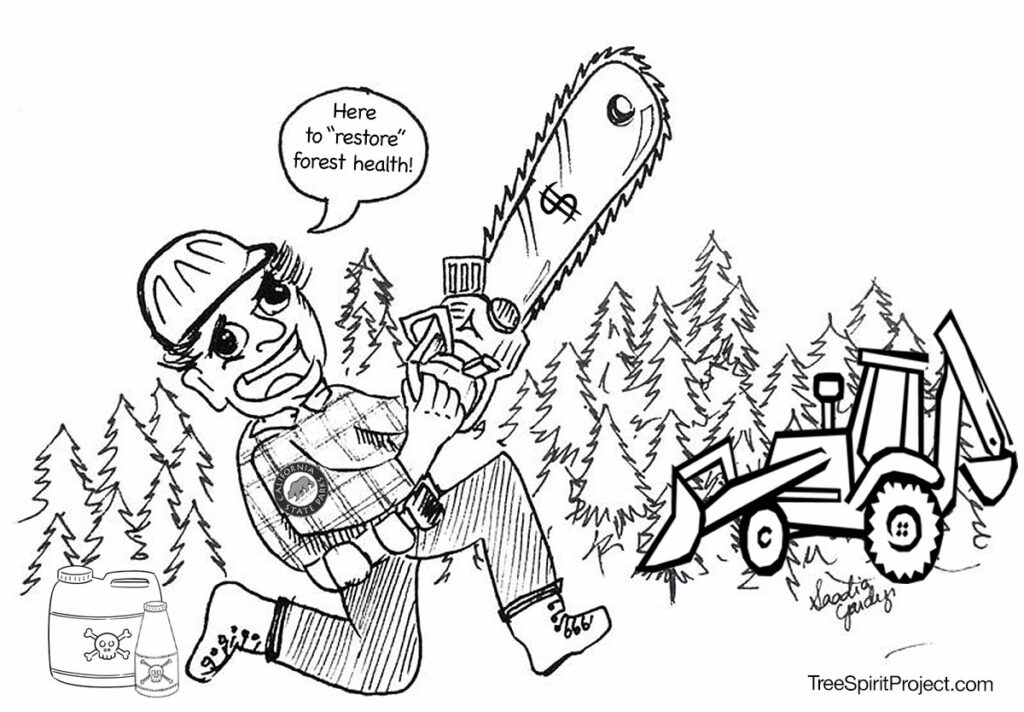
At this critical time of an anthropogenic (human-caused) climate crisis, we should be cherishing and protecting wild, dense, unmanaged forests more than ever, for their unrivaled carbon-storage and cooling services,
Instead these agencies are promoting exactly the opposite; teaching us to fear, demonize and then assault forests with industrial machines. To “clean them up” and “thin” them. Instead of spurring forest growth and expansion, fear of wildfire is leveraged to scare people into supporting cutting down forests everywhere.
For decades, the logging industry and, sadly, the U.S. Forest Service, have successfully popularized a false, fear-driven narrative to justify logging (“thinning”), leveraging the powerful fear of wildfire to advance projects. The popularized Myth: claim long term fire suppression has created a dangerous buildup of “fuel”, which creates a threat of “catastrophic” forest-destroying wildfires — and this necessitates “management” projects like this one. Forests are labeled threats to be feared and assaulted with “treatments.”

Ph.D. ecologist Chad Hanson, director of Earth Island Institute’s John Muir Project, is one scientist who has worked for years to create data debunking this forest-logging narrative. His myths-busting book, “Smokescreen: Debunking Wildfire Myths to Save Our Forests and Our Climate.”
Hanson’s extensive research reveals that the opposite is true, that “thinned” forests ignite more readily and burn faster because they are sunnier, hotter, drier and windier.
Yes, the park’s bishop pines are aging. But they could live another hundred years or more — if left undisturbed. Or a lightning strike might ignite a productive, regenerative forest fire in the decades ahead. Pine stand replacement may come on its own, natural timetable — not one artificially imposed by bureaucracies.
Cal Parks and CalFire have institutional incentives to aggressively manage millions of acres of California wildlands with chainsaws, masticators and herbicides. But in our era of climate crisis, forest-diminishing projects like this one release huge amounts of stored forest carbon. And emit still more carbon with petroleum-powered machinery.
Don’t be fooled into supporting the destruction of more of our most precious global cooling commodity: wild, unmanaged forests. We’ve been assaulting forests for decades. They won’t be restored with more of the same.
The real danger lies not in our forests, but in our psyche. Separated from Mother Nature, we now fear her, strive to control her, and are managing her to death.
A SHORTER VERSION of this essay was published a “Marin Voice” opinion piece in the Marin Independent Journal on March 10, 2023: https://www.marinij.com/2023/03/09/marin-voice-dont-let-tomales-bay-state-park-get-managed-to-death/

